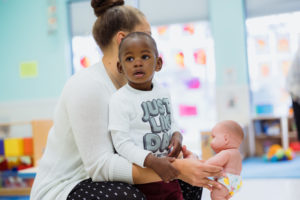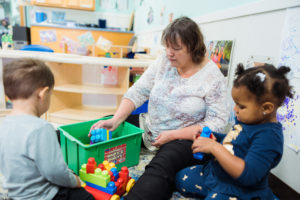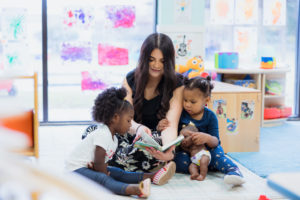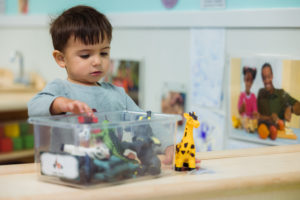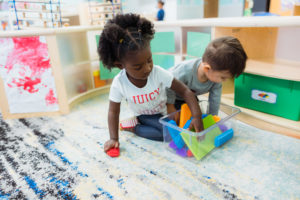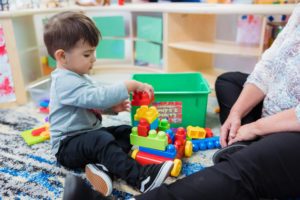Yes, Your Child Is Learning Through Play. Here’s How.
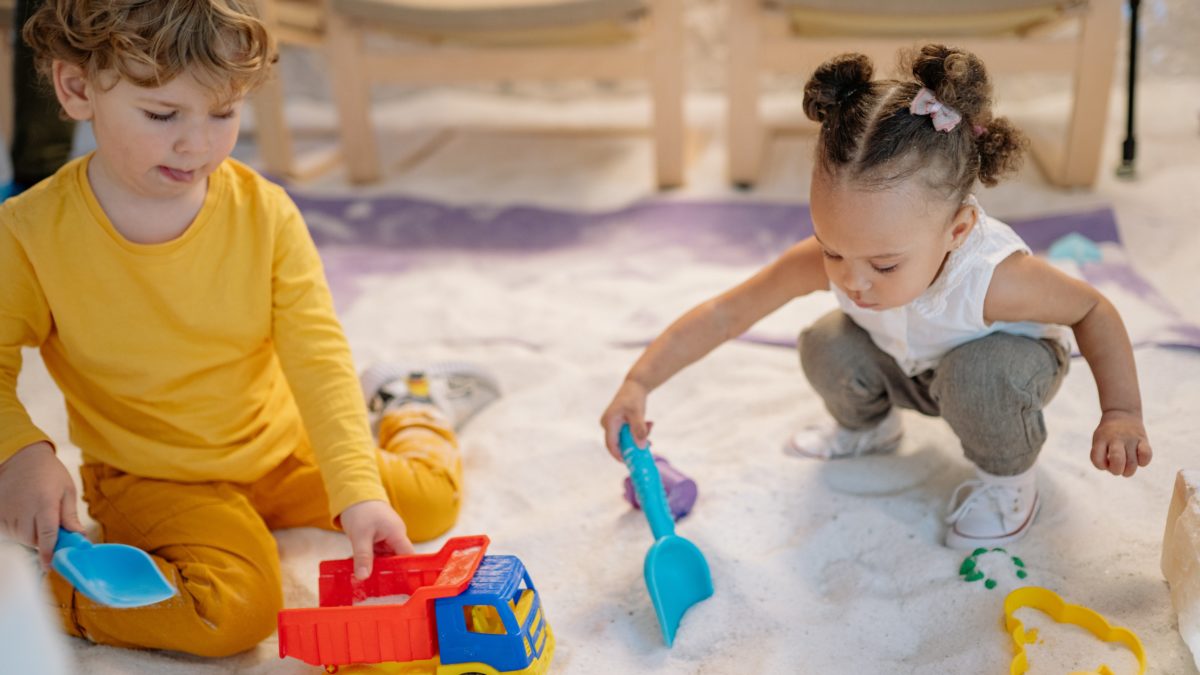
Walk into any preschool classroom in North Carolina and you’ll likely be greeted with children playing together or interacting with early childhood educators. While many of us might hold the preconceived notion that children learn through worksheets or time spent at a desk, in preschool, the opposite is true.
The very act of playing provides children the freedom to use their imagination and explore as they wish. Historically, free play and exploration were how children learned to solve problems, develop their own interests, and make connections with each other.
As parents and caregivers, it can be tempting to underestimate the value of play. Keep reading for an in-depth look at what learning at play means for your child—and how you can help instill a love of play and learning at home.
What is Play?
Because the concept of play encompasses many different elements, it can be challenging to answer. At One Place, we think of play as child-initiated, child-directed, and open-ended. It focuses on the process rather than the product—such as goals or achievements.
Core Benefits of Play and Learning
Play is a critical tool for children to understand themselves and the world around them. Through play, children are impacted in numerous ways, including:
- Problem-Solving: Divergent problem-solving, which means multiple solutions to a single challenge, is a critical skill for children—and one that’s often in direct opposition to worksheets or standardized tests. Divergent thinking and problem-solving can involve collaboration and exploration.
- Imagination: Pretend play fosters imagination and creativity, two critical skills for young people to develop. Playfulness and creativity often go hand-in-hand—and these skills can help build confidence, creative expression, and self-esteem.
- Physical Development: Physical activities have a direct impact on the entire body as well as the brain. When children play together physically, it has positive effects on their present and their future.
- Literacy, Math, and Scientific Skills: Through play, children develop math, literacy, and scientific skills—from running a pretend grocery store and doing the math, to playing with stuffed animals and learning different breeds of dogs.
Different Types of Play
Creative Curriculum, the curriculum used by nearly all preschool programs in North Carolina, defines 10 core types of play and learning that are promoted in the classroom. We recommend clicking here to access additional resources and details about Creative Curriculum and how you can support your child with learning and play at home.
- Dramatic Play: Central to your child’s healthy development and learning is creative and imaginative play—otherwise known as dramatic play. During this time, children play “make-believe” and learn how to collaborate with their peers, solve problems, and think abstractly. Encourage this kind of pretend play at home by playing with your child and providing simple props—an empty cardboard box can become a rocket ship!
- Blocks: Perhaps deceptively simple, blocks support children with math concepts and language development. Encourage your child at home to learn through block play by taking an interest in their creations.
- Manipulative Toys and Games: When your child interacts with toys and games, such as puzzles, small construction materials, legos, board games, or collections of objects, they explore how things work, strengthen their fine motor skills, and work collaboratively to solve problems. At home, provide safe and appropriate toys for your child to enjoy. Then, engage with them as they play by observing, playing together, imagining different possibilities, and enjoying the time shared.
- Art: Through different mediums of art, children receive the opportunity to express original feelings, thoughts, and ideas. At home, provide your child with various materials—such as crayons, paper, scissors, glue, or collage items—and encourage them to express their creativity with freedom and joy.
- Sensory: Both water and sand are a core part of the Creative Curriculum. If your child loves playing with sand or water, consider setting up sensory activities at home. This can be as simple as a water tub or sandbox outside. Provide your child with measuring cups and spoons, plastic animals, toy boats, and funnels to experiment with.
- Library: In the classroom, the library area is a critical element that offers a foundation for reading, writing, and critical thought. The most important activity you can do with your child every day is read together. During your reading time, encourage your child to share their thoughts on the stories you read or provide them with paper and pencils to explore their own writing endeavors.
- Music and Movement: Singing and dancing to music facilitates self-expression and physical activity. Try setting aside some time each day to listen to music with your child and aim for a diverse mix of genres—from reggae to country to classical.
- Cooking: Whether you’re a passionate home cook or not, encourage your child in the kitchen. While cooking with a young person might take extra time or involve more messiness, the value gained is worth it. By measuring recipes or stirring the batter, your child’s vocabulary will grow and they’ll learn more about math, literacy, and science.
- Outdoors and Gym: Physical exercise is key to a healthy and happy emotional state of being. At home, try to spend time with your child outside. Take walks in your neighborhood, visit the neighborhood park, and discuss what you’re seeing in nature. Encourage your child to collect items and then sort them or make them into patterns and art.
- Discovery and Science: Science is all around us—from making bubbles while washing dishes to boiling water for a cup of tea. As a parent or caregiver, seek out opportunities to encourage and facilitate your child’s scientific thinking throughout daily activities. Think of playing with tools, taking a bath, baking cookies, or playing in the yard.
Encouraging Play
Open-ended questions and supportive interactions are one of the most effective opportunities to promote and facilitate healthy play at home. Consider the following questions when playing at home with your child:
Dramatic Play
- What would you like to pretend?
- What are you cooking?
- What ingredients are you going to use? What else?
- How can we pretend to be ___?
- What’s your favorite thing to play in this area? Why?
- How do you know what to feed your baby?
- How do you know when he is hungry or tired?
- How do you think your food will make people feel?
- Where do you learn to make that?
- Why do you think ____ wears those kinds of clothes?
- What else do ____ need to do their work?
- Who have you seen do that before?
Art
- What can you tell me about your art?
- How did you get the idea for this?
- What do you like the most about your picture?
- What do you think you should call it?
- Why did you use this color?
- How were you feeling when you made this?
- How hard was it to create this?
- Would you change anything about your art?
- What should we do next with this?
- How do you think your art will make people feel?
Block Center
- How did you build that?
- Tell me about the structure you built.
- Why doesn’t your tower fall down?
- How can we use these to build something long?
- How can we make a bridge over your structure?
- What else could you try?
- How could you make it taller? Longer?
- How is ___ and ___ the same? Different?
- How can you use these differently?
- How can we figure out which has more blocks?
Sensory Play
- Can you tell me about what you’re working on?
- What else could you do with it?
- How does this material feel to you?
- What do you notice about this material?
- What do you think will happen if you add more?
- What could you do to keep it from the floor?
- What made you choose sensory play today?
- What does this remind you of?
- What do you like best about this material?
- How many scoops do you think you need to fill it up?
- Where do you think this material came from?
- Your shovel is blue. What other things are blue?
Science
- What are you working on?
- What do you notice? See? Observe?
- How do you make this work?
- Why do you think that happened?
- How did you do that?
- What do you think will happen if ___?
- How can we find out?
- How are these alike? Different?
- When have you seen something like this before?
- How does that feel?
- Can you tell me about what you are making?
- How else could you solve that problem?
Math Center
- What are you working on?
- Tell me about your project.
- What are your plans for those?
- What do you see? Notice?
- How did you make this work?
- Tell me about what you are doing? Making?
- Which is the longest? Shortest? How come?
- How are these alike or different?
- Why do you think that happened?
- How can we find out if ___?
- Which has more? Less? How do you know?
- Which is heavier? Lighter? How do you know?
Learn More About One Place
If your child is currently enrolled in a preschool program in Onslow County and you’re interested in parenting classes or trainings, we’re here to help. One Place offers a number of trainings each month that are designed for both parents and early childhood educators. View the available offerings here.
Learn more and sign up for a training here.
If your child is not yet enrolled in preschool, we administer three preschool programs at no cost to eligible families in Onslow County: North Carolina Pre-Kindergarten for 4-year-olds, Three School for 3-year-olds, and Early Head Start for children 6-weeks to 3 years old.
Learn more and apply for preschool programs here.

